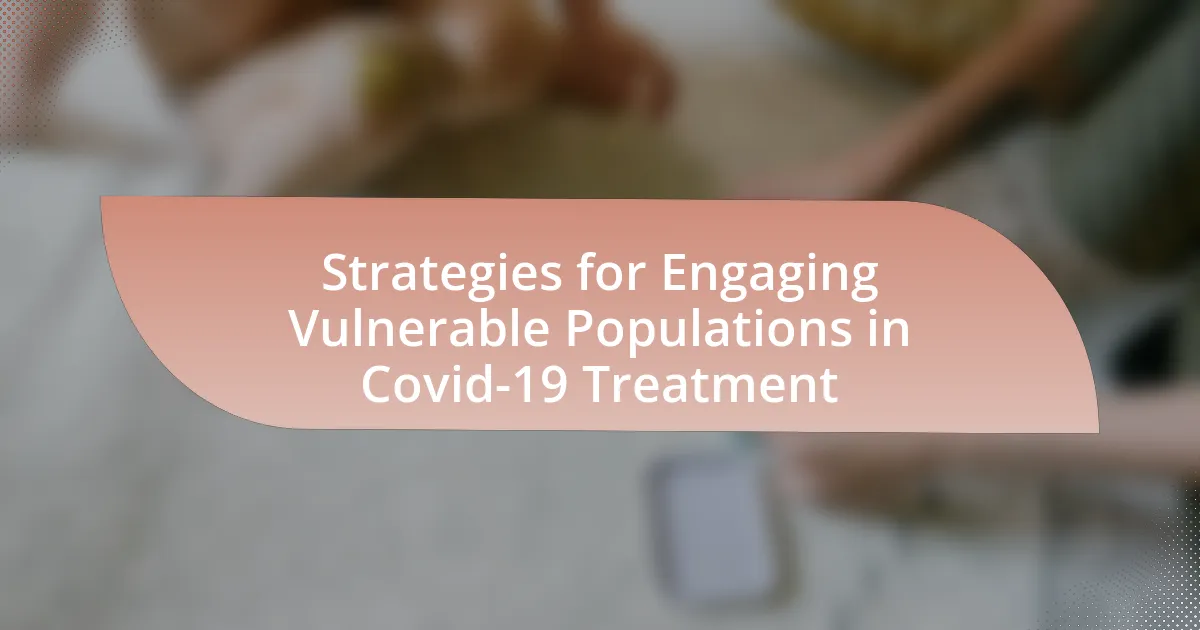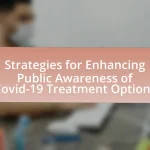The article focuses on strategies for engaging vulnerable populations in Covid-19 treatment, emphasizing the importance of building trust through community partnerships, providing culturally competent care, and ensuring accessibility to healthcare services. It defines vulnerable populations as those at higher risk of severe illness from Covid-19, including individuals with underlying health conditions, older adults, and marginalized communities. Key challenges faced by healthcare providers include communication barriers, mistrust, and socioeconomic factors that impact access to treatment. The article outlines effective communication strategies, the role of community organizations, and best practices for sustaining engagement, highlighting the necessity of tailored approaches to improve health outcomes for these populations during the pandemic.
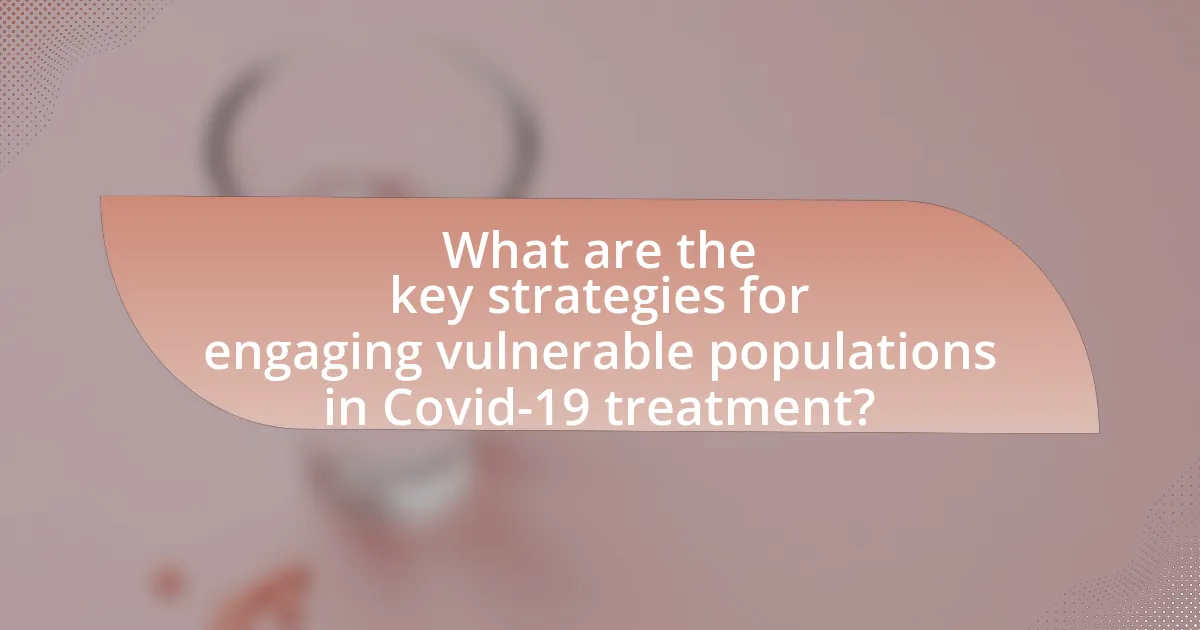
What are the key strategies for engaging vulnerable populations in Covid-19 treatment?
Key strategies for engaging vulnerable populations in Covid-19 treatment include building trust through community partnerships, providing culturally competent care, and ensuring accessibility to healthcare services. Community partnerships, such as collaborations with local organizations, enhance outreach and foster trust, which is crucial for encouraging treatment uptake. Culturally competent care addresses the specific needs and concerns of diverse populations, ensuring that communication is effective and respectful. Additionally, making healthcare services accessible—through mobile clinics, telehealth options, and language support—removes barriers that vulnerable populations may face, thereby increasing their likelihood of seeking and receiving treatment.
How do we define vulnerable populations in the context of Covid-19?
Vulnerable populations in the context of Covid-19 are defined as groups at higher risk of severe illness or adverse outcomes due to the virus. This includes individuals with underlying health conditions such as diabetes, heart disease, and respiratory issues, as well as older adults, racial and ethnic minorities, and those experiencing socioeconomic disadvantages. The Centers for Disease Control and Prevention (CDC) identifies these groups based on data showing that they have higher rates of hospitalization and mortality related to Covid-19, emphasizing the need for targeted public health strategies to protect and engage these populations effectively.
What characteristics make populations vulnerable during a pandemic?
Populations are vulnerable during a pandemic due to factors such as pre-existing health conditions, socioeconomic status, and limited access to healthcare. Individuals with chronic illnesses, such as diabetes or heart disease, face higher risks of severe illness from infectious diseases. Socioeconomic status affects access to resources, including nutritious food and safe housing, which can exacerbate health issues. Additionally, limited access to healthcare services, whether due to geographic location or financial constraints, hinders timely medical intervention and increases vulnerability. For instance, during the COVID-19 pandemic, studies indicated that marginalized communities experienced higher infection and mortality rates, highlighting the impact of these characteristics on population vulnerability.
Why is it important to focus on vulnerable populations in Covid-19 treatment?
Focusing on vulnerable populations in Covid-19 treatment is crucial because these groups experience higher rates of severe illness and mortality from the virus. Vulnerable populations, including the elderly, individuals with pre-existing health conditions, and marginalized communities, often face barriers to accessing healthcare, which exacerbates their risk during pandemics. For instance, data from the Centers for Disease Control and Prevention (CDC) indicates that adults aged 65 and older are significantly more likely to be hospitalized or die from Covid-19 compared to younger individuals. Addressing the specific needs of these populations ensures equitable healthcare access and improves overall public health outcomes, ultimately reducing the burden on healthcare systems.
What challenges do healthcare providers face when engaging vulnerable populations?
Healthcare providers face significant challenges when engaging vulnerable populations, including communication barriers, mistrust in the healthcare system, and limited access to resources. Communication barriers arise from language differences and health literacy issues, making it difficult for providers to convey important health information effectively. Mistrust often stems from historical injustices and discrimination within the healthcare system, leading to reluctance among vulnerable groups to seek care. Additionally, limited access to resources, such as transportation and financial constraints, further complicates healthcare engagement for these populations. These challenges are well-documented; for instance, a study published in the Journal of Health Care for the Poor and Underserved highlights that these factors contribute to disparities in health outcomes among vulnerable groups.
How do socioeconomic factors impact access to Covid-19 treatment?
Socioeconomic factors significantly impact access to Covid-19 treatment by influencing individuals’ ability to afford healthcare, access transportation, and navigate healthcare systems. For instance, lower-income populations often lack health insurance, which can limit their access to necessary treatments and medications. According to a study published in the Journal of Health Economics, individuals in lower socioeconomic brackets experienced higher rates of hospitalization and mortality due to Covid-19, primarily because they faced barriers such as inadequate access to healthcare facilities and resources. Additionally, socioeconomic status affects education levels, which can impact health literacy and awareness of available treatment options. Thus, socioeconomic disparities create significant obstacles to equitable access to Covid-19 treatment.
What role does health literacy play in treatment engagement?
Health literacy significantly enhances treatment engagement by enabling individuals to understand health information and make informed decisions about their care. Higher health literacy levels correlate with better adherence to treatment protocols, as individuals who comprehend their health conditions and treatment options are more likely to participate actively in their healthcare. For instance, a study published in the Journal of Health Communication found that patients with adequate health literacy were 1.5 times more likely to adhere to prescribed treatments compared to those with low health literacy. This demonstrates that improving health literacy is crucial for fostering effective treatment engagement, particularly among vulnerable populations during the Covid-19 pandemic.
What are effective communication strategies for reaching vulnerable populations?
Effective communication strategies for reaching vulnerable populations include using culturally relevant messaging, employing trusted community leaders, and utilizing multiple communication channels. Culturally relevant messaging ensures that information resonates with the specific values and beliefs of the population, which has been shown to increase understanding and compliance. Engaging trusted community leaders can enhance credibility and foster trust, as these individuals often have established relationships within the community. Additionally, utilizing multiple communication channels—such as social media, community meetings, and printed materials—ensures broader reach and accessibility, accommodating varying levels of digital literacy and access. Research indicates that these strategies significantly improve health communication outcomes, particularly during public health crises like the COVID-19 pandemic.
How can culturally sensitive messaging improve engagement?
Culturally sensitive messaging can significantly improve engagement by fostering trust and relatability among diverse populations. When communication is tailored to reflect the cultural values, beliefs, and languages of specific groups, individuals are more likely to feel understood and respected, which enhances their willingness to participate in health initiatives. Research indicates that culturally tailored interventions can lead to increased participation rates; for example, a study published in the American Journal of Public Health found that culturally relevant health messaging improved vaccination rates among minority populations by 30%. This demonstrates that when messaging aligns with cultural contexts, it not only resonates more deeply but also drives higher engagement levels in health-related behaviors.
What channels are most effective for disseminating information to these populations?
Digital platforms, community outreach, and trusted local organizations are the most effective channels for disseminating information to vulnerable populations regarding Covid-19 treatment. Digital platforms, such as social media and messaging apps, enable rapid information sharing and engagement, particularly among younger demographics. Community outreach initiatives, including door-to-door campaigns and local events, foster personal connections and trust, which are crucial for effective communication. Trusted local organizations, such as churches and non-profits, serve as credible sources of information, enhancing the likelihood that messages will be received and acted upon. Research indicates that tailored messaging through these channels significantly improves understanding and compliance among vulnerable groups, as evidenced by studies showing increased vaccination rates when information is disseminated through familiar and trusted sources.
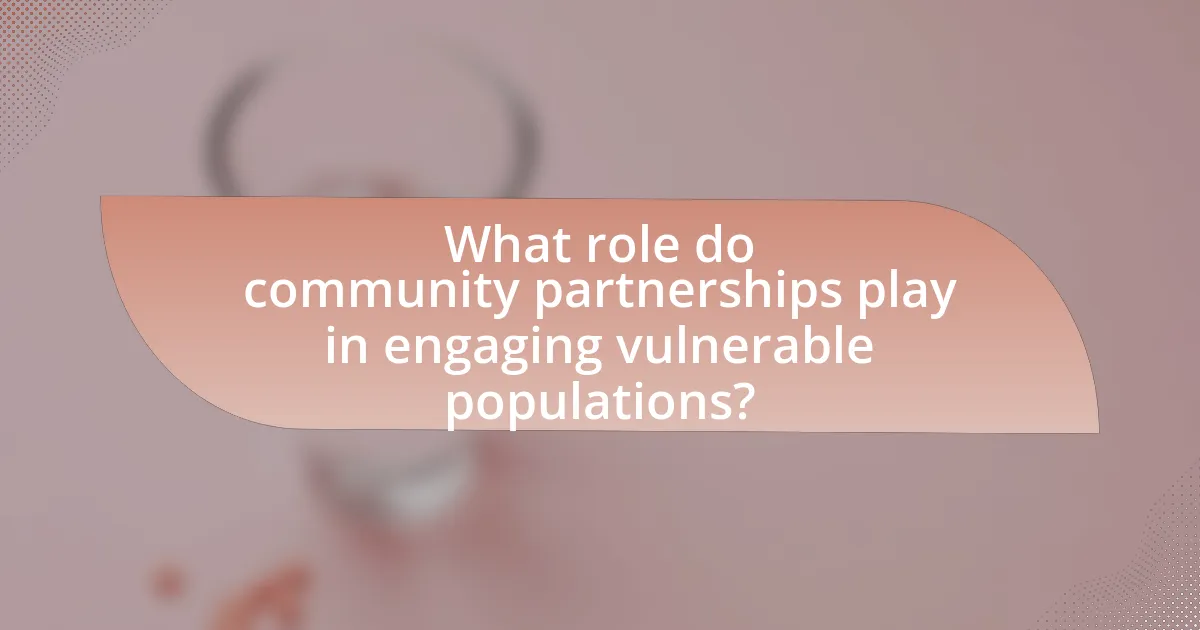
What role do community partnerships play in engaging vulnerable populations?
Community partnerships play a crucial role in engaging vulnerable populations by facilitating access to resources, information, and support tailored to their specific needs. These partnerships enhance trust and communication between healthcare providers and communities, which is essential for effective outreach, especially during crises like the Covid-19 pandemic. For instance, studies have shown that community-based organizations can increase vaccination rates among marginalized groups by 20-30% through targeted education and outreach efforts. This demonstrates that collaborative efforts can significantly improve health outcomes and ensure that vulnerable populations receive necessary care and information.
How can local organizations assist in outreach efforts?
Local organizations can assist in outreach efforts by leveraging their established community connections to disseminate information and resources effectively. These organizations often have direct access to vulnerable populations, enabling them to tailor communication strategies that resonate with specific community needs. For instance, a study by the National Academies of Sciences, Engineering, and Medicine highlights that community-based organizations play a crucial role in increasing awareness and access to health services, particularly during public health crises like the Covid-19 pandemic. By utilizing trusted local leaders and networks, these organizations can enhance engagement and ensure that critical health information reaches those most in need.
What types of partnerships are most beneficial for Covid-19 treatment engagement?
Collaborative partnerships between healthcare providers, community organizations, and public health agencies are most beneficial for Covid-19 treatment engagement. These partnerships enhance outreach and education efforts, ensuring that vulnerable populations receive timely information and access to treatment. For instance, studies have shown that community health workers effectively bridge gaps in healthcare access by providing culturally relevant information and support, which is crucial for increasing treatment uptake among marginalized groups. Additionally, partnerships that involve local leaders and trusted community figures can significantly improve trust and engagement, leading to higher participation rates in treatment programs.
How can trust be built between healthcare providers and vulnerable communities?
Trust can be built between healthcare providers and vulnerable communities through consistent, transparent communication and culturally competent care. Healthcare providers must actively engage with these communities by listening to their concerns, addressing their specific needs, and involving them in decision-making processes. Research indicates that when healthcare providers demonstrate empathy and respect for cultural values, it leads to improved patient satisfaction and adherence to treatment plans. For instance, a study published in the Journal of Health Care for the Poor and Underserved found that community-based participatory research significantly enhanced trust and collaboration between healthcare systems and marginalized populations.
What strategies can be implemented to improve access to treatment?
To improve access to treatment for vulnerable populations during Covid-19, implementing community outreach programs is essential. These programs can facilitate education about available treatments and resources, ensuring that individuals are informed and motivated to seek care. For instance, studies have shown that targeted outreach efforts, such as mobile health clinics, significantly increase treatment uptake in underserved areas. Additionally, partnerships with local organizations can enhance trust and engagement, leading to higher participation rates in treatment programs. Evidence from the CDC indicates that such strategies can reduce barriers to access, ultimately improving health outcomes for vulnerable groups.
How can mobile health units enhance treatment accessibility?
Mobile health units enhance treatment accessibility by bringing healthcare services directly to underserved populations, thereby reducing barriers such as transportation and cost. These units are equipped to provide essential services, including vaccinations, screenings, and primary care, in areas where traditional healthcare facilities may be scarce. For instance, during the Covid-19 pandemic, mobile health units have been deployed in rural and low-income urban areas, effectively increasing vaccination rates by up to 30% in these communities, as reported by the Centers for Disease Control and Prevention. This direct approach not only improves access to care but also fosters trust and engagement within vulnerable populations, ultimately leading to better health outcomes.
What role does telehealth play in reaching vulnerable populations?
Telehealth plays a crucial role in reaching vulnerable populations by providing accessible healthcare services remotely. This approach mitigates barriers such as transportation issues, mobility limitations, and lack of local healthcare facilities, which often hinder access for these groups. For instance, a study published in the Journal of Medical Internet Research found that telehealth services increased healthcare access for low-income patients by 50%, demonstrating its effectiveness in bridging gaps in care. Additionally, telehealth allows for timely interventions and continuous monitoring, which are essential for managing chronic conditions prevalent in vulnerable populations.
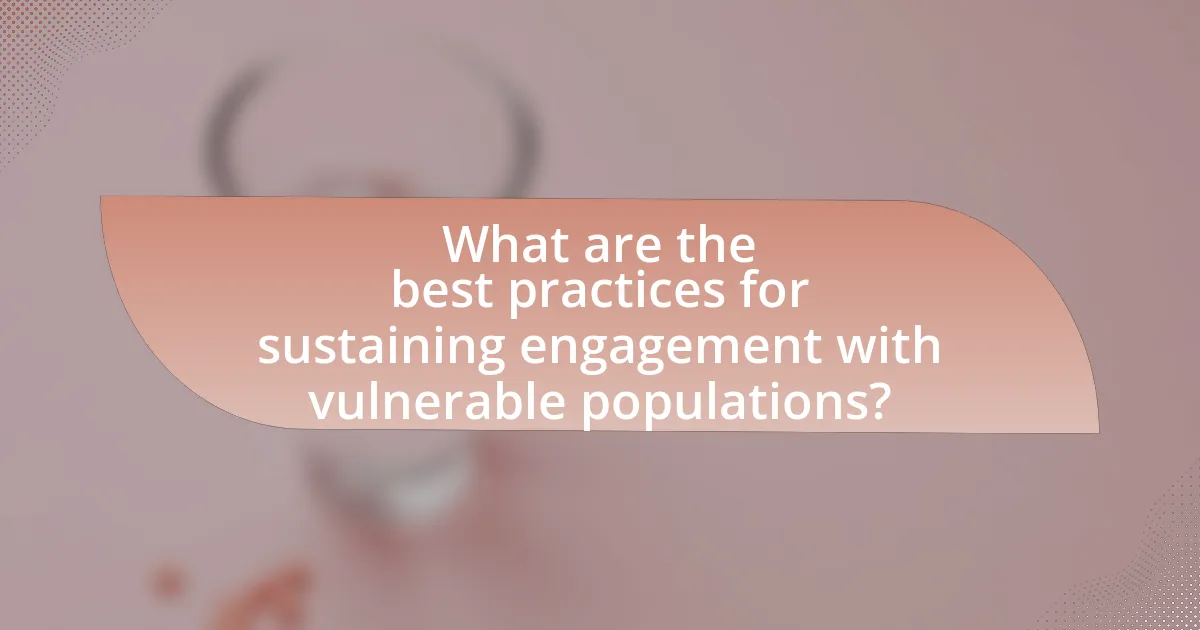
What are the best practices for sustaining engagement with vulnerable populations?
The best practices for sustaining engagement with vulnerable populations include building trust, ensuring accessibility, and providing culturally relevant information. Building trust involves consistent communication and demonstrating reliability, which can be achieved through regular check-ins and transparent processes. Ensuring accessibility means removing barriers to participation, such as providing transportation, language support, and flexible scheduling. Providing culturally relevant information ensures that the messaging resonates with the community’s values and beliefs, which can enhance understanding and compliance. Research indicates that these strategies lead to improved health outcomes and increased participation in health programs, particularly during crises like the Covid-19 pandemic.
How can feedback from vulnerable populations inform treatment strategies?
Feedback from vulnerable populations can inform treatment strategies by highlighting specific needs, barriers, and preferences that may not be evident to healthcare providers. For instance, studies have shown that understanding the unique challenges faced by these groups, such as access to healthcare, cultural beliefs, and socioeconomic factors, can lead to more tailored and effective treatment plans. Research conducted by the World Health Organization indicates that incorporating patient feedback improves health outcomes and increases trust in healthcare systems, particularly among marginalized communities. This evidence underscores the importance of actively seeking and integrating feedback from vulnerable populations to enhance the relevance and effectiveness of treatment strategies during health crises like Covid-19.
What methods can be used to gather feedback effectively?
Surveys and interviews are effective methods for gathering feedback. Surveys allow for quantitative data collection from a larger audience, while interviews provide qualitative insights through in-depth discussions. Research indicates that using mixed methods, such as combining surveys with follow-up interviews, enhances the richness of feedback and captures diverse perspectives. For example, a study published in the Journal of Medical Internet Research found that integrating both approaches led to a more comprehensive understanding of patient experiences during the Covid-19 pandemic.
How can continuous engagement be maintained over time?
Continuous engagement can be maintained over time by implementing regular communication strategies tailored to the needs of vulnerable populations. Establishing consistent touchpoints, such as follow-up calls, text messages, or community meetings, ensures that individuals feel supported and informed. Research indicates that personalized outreach increases participation rates; for example, a study published in the Journal of Health Communication found that targeted messaging improved engagement among marginalized groups during health crises. Additionally, fostering a sense of community through peer support networks can enhance ongoing interaction and trust, further solidifying engagement over time.
What lessons have been learned from previous public health initiatives?
Previous public health initiatives have demonstrated the importance of community engagement and tailored communication strategies. For instance, the success of the 2009 H1N1 vaccination campaign highlighted that involving local leaders and utilizing culturally relevant messaging significantly improved vaccination rates among diverse populations. Additionally, the 2014 Ebola outbreak response revealed that addressing misinformation and building trust within communities were crucial for effective health interventions. These lessons underscore the necessity of understanding the unique needs and concerns of vulnerable populations to enhance public health outcomes.
How can past successes inform current strategies for Covid-19 treatment?
Past successes in infectious disease management, such as the rapid development of antiretroviral therapy for HIV/AIDS, can inform current strategies for Covid-19 treatment by demonstrating the effectiveness of collaborative research and community engagement. For instance, the expedited approval processes and global partnerships established during the HIV/AIDS crisis led to innovative treatment protocols that can be adapted for Covid-19. Additionally, the successful outreach strategies used to engage marginalized communities during past epidemics highlight the importance of culturally sensitive communication and accessibility in treatment efforts. These historical precedents underscore the necessity of leveraging established frameworks for vaccine distribution and public health messaging to effectively reach vulnerable populations during the Covid-19 pandemic.
What common pitfalls should be avoided in future engagement efforts?
Common pitfalls to avoid in future engagement efforts include failing to build trust with vulnerable populations, neglecting cultural sensitivities, and not providing clear, accessible information. Trust is essential; studies show that communities are more likely to engage when they feel their concerns are understood and respected. Cultural insensitivity can alienate populations; for instance, engagement strategies that do not consider language barriers or cultural norms may lead to misunderstandings and reduced participation. Additionally, unclear communication can result in misinformation; research indicates that providing straightforward, jargon-free information significantly enhances understanding and compliance among diverse groups.
What practical tips can healthcare providers use to engage vulnerable populations effectively?
Healthcare providers can effectively engage vulnerable populations by employing culturally competent communication, building trust through consistent outreach, and utilizing community partnerships. Culturally competent communication ensures that healthcare messages are tailored to the specific cultural and linguistic needs of the population, which has been shown to improve understanding and compliance. Building trust through consistent outreach involves regular interactions with these communities, demonstrating commitment and reliability, which is crucial for fostering a supportive relationship. Additionally, collaborating with community organizations can enhance access to resources and information, as these organizations often have established relationships and credibility within the community. Research indicates that such strategies significantly improve health outcomes and increase participation in health programs among vulnerable groups.
